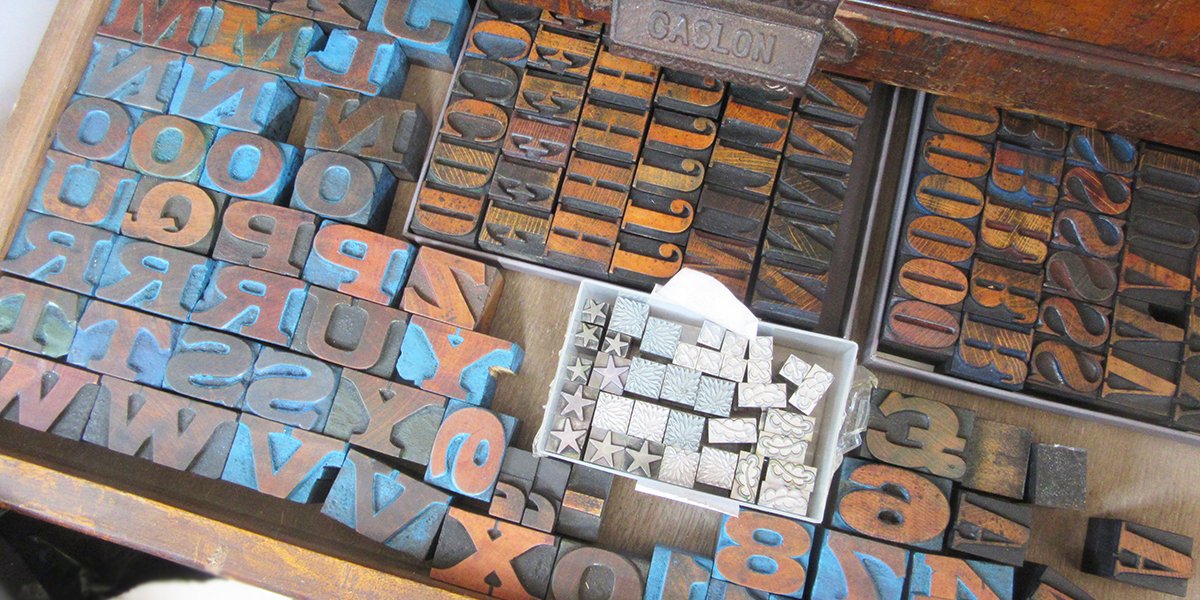What’s the difference between different print methods?
(And why does it matter?)
In my last blog, we looked at some commonly used print industry terminology, to help guide you through it all. Building on that theme, I thought it might be useful to look in a bit more detail about the different types of printing process available. It’s not uncommon for us printy-types to get carried away talking about the process while completely forgetting to tell you what they are good for! I’d like to address that now, so here goes.
Letterpress Printing
Block printing is (arguably) the oldest form of printing, where movable type letters or an embossed image are used as the ‘master’ to transfer the ink to paper. Although today’s commercial printing machines have very little resemblance to anything William Caxton would recognise the principle is not a million miles away. Letterpress printing has evolved from this.
Letterpress printing blocks
How does it work?
A raised surface – like the block letters in the photo, normally a polymer plate nowadays – captures the text, image or layout that you want to print. Ink is then applied to the raised areas and the printing material is pressed down. The image is then ‘stamped’ on to the printing material.
What is it good for?
Modern day Letterpress is excellent for creating a fine and luxurious tactile impression. It has a traditional feel, often leaving a slight indentation in the paper giving a super, tactile quality. It is relatively slow, particularly as each colour needs to be printed separately. Many traditional letterpress printing presses – like the Heidelberg platen press, launched in 1914 – are still in use in commercial printers today but have been adapted to apply foil finishes or to cut shapes instead.
Lithographic Printing
If letterpress uses a raised image or text to print from, lithographic printing uses an etched image. Ink sitting in the hollows on the plate surface are transferred to a printing surface called a ‘blanket’ and then onto the final sheet. This is where we get the term ‘offset litho’ as the image is actually set off to the blanket before printing onto the paper.
How does it work?
Lithography works by laser etching your image onto a metal plate. The plate is then inked to transfer the image to a blanket and then onto the paper. Most offset litho machines now run four colour process (CMYK) as standard; that is, all four colours are printed at the same time going through the press, unlike letterpress when you have to print each colour separately. It would only be if you have chosen additional special colours, like metallics, that you’d need an additional print. After printing, the ink oxidises or dries on the paper, often with the help of UV dryers or spray powder. Modern day inks are vegetable based.
What is it good for?
Because it’s fast, consistent and can reproduce sharp details litho printing tends to be most cost-effective for big volume print runs. If you’re looking for thousands of magazines, brochures or flyers, litho is probably your go to choice. (The Ryobi B3 sheet fed press in the image above can print up to 5000 sheets per hour, for example).
Digital Printing
Digital printing in commercial terms can be either toner based or ink based. For many years HP Indigo presses have been the Rolls Royce of the digital print world, rivalling litho quality, with instant drying so it can be finished straight away. Many other toner-based systems have also developed dramatically in recent years – especially on textured or coated papers so you don’t get the shiny finish of colour copiers of years gone by.
Because with digital you are printing direct to paper, without the need to create a plate to print from, not every copy has to be exactly the same. For example, you can personalise or merge data into the job as you print.
How does it work?
Inkjet Printers: use print heads that deposit tiny droplets of ink onto the paper or other media, creating the image.
Laser Printers: use a laser beam to "write" the image onto a drum, which then attracts toner (a powdered ink) to form the image. The toner is then transferred to the paper and fused (heated) to set it permanently. (from HP principle of digital printing)
What is it good for?
Digital printing tends to be better suited to shorter print runs, or for jobs that need a rapid turnaround it’s an almost instant process: the sheets come off the press dry, ready for finishing.
It can be argued that digital is more environmentally friendly as there is less waste. There are no plates required. You can print one sheet as a proof copy, then, if all is well you press print, saving on materials. All digital ink/toner is completely recyclable after it’s been used to print and it’s a waterless process.
Modern printing: help and advice
Hopefully this article has helped to explain the differences between the common, commercially available print processes and hopefully it’s been an interesting and not too print-geeky read! But if you ever need any advice on which type of process is going to be right for your print job, please remember that’s what I’m here for!
Digital printing today is much more flexible than the more traditional commercial print types, in terms of what can be delivered and the speed at which it can be done. That said, I always say that craftsmanship isn’t a quick turnaround; quality takes time and there are no shortcuts.


